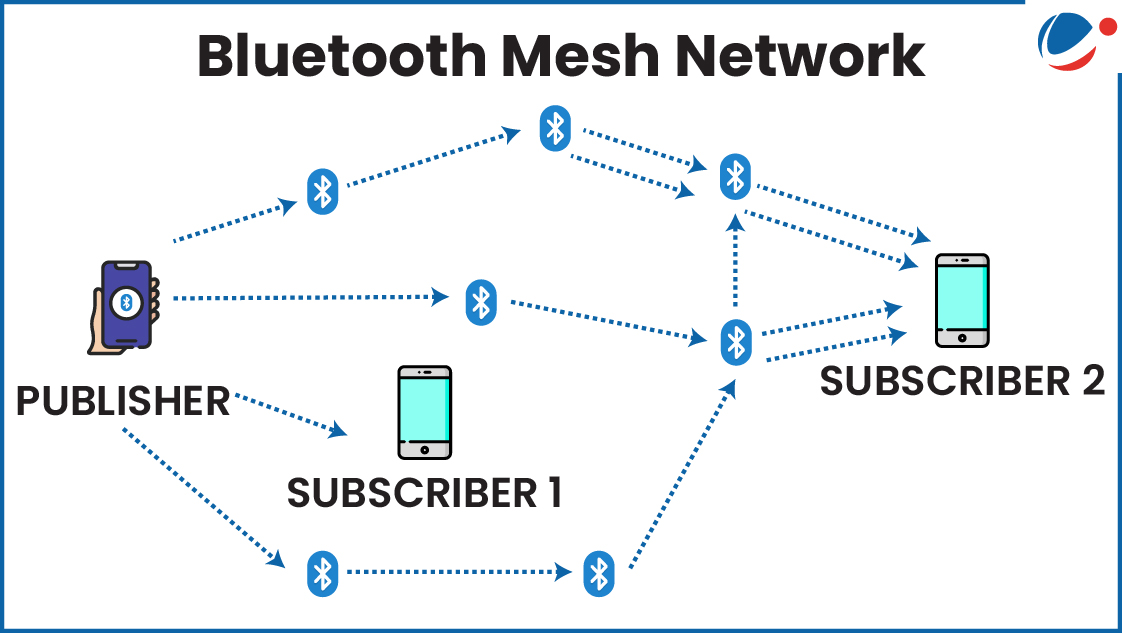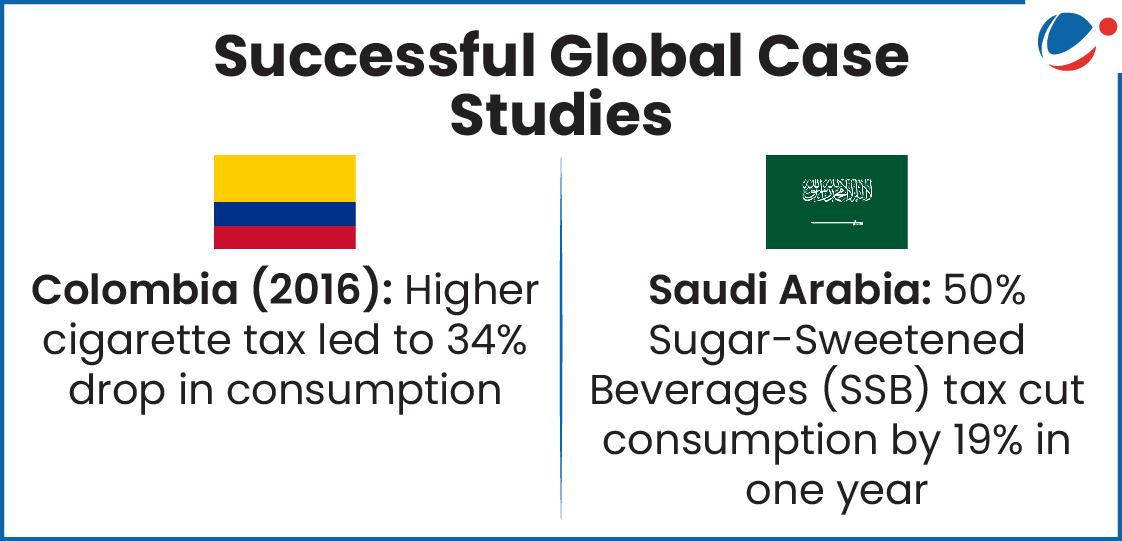Bluetooth Mesh Networking
Twitter Co-Founder shared details of Bluetooth Messaging App, Bitchat.
- Bitchat is a new peer-to-peer messaging app that communicates without a centralised server or phone network.
- Bitchat relies on Bluetooth Low Energy Mesh Networking to enable communication
What is Bluetooth Mesh Networking?
- It relies on Bluetooth clusters or Mesh network created by devices in a range.
- Mesh network, also known as “multi-hop network”, is a networking topology.
- In it, data can travel from any device to all others, achieving many-to-many communication.
- Even if one device fails, the network keeps working.
- Messages are broadcast and relayed by nodes until they reach the intended destination.
- When a Bluetooth device joins a Mesh network, it becomes a node

Potential Benefits of Bluetooth Mesh Networking
- No central database: the messages are stored entirely on users’ devices and are deleted after a short period.
- This design is created to prioritise users’ privacy.
- Also, Messages are end-to-end encrypted and do not leave the network.
- No registration required: Users are not required to create accounts using their email or phone number, making the communication anonymous.
- Other: Low Power Consumption, etc.
Key Limitations: high latency, Complex network management, low data transfer rates, etc.
- Tags :
- Bitchat
- Bluetooth Messaging
AI Alliance Network (AIANET)
The Digital India Foundation (DIF), a founding member of the AIANET, has objected to the membership application of Pakistan's AI Technology Centre (AITeC) to AIANET.
- Digital India Foundation (DIF) is a not-for-profit think-tank aiming to foster digital inclusion and adoption, and the use of the Internet and related technologies for the developmental process.
About AIANET
- About: It is an informal voluntary network and community for its Members to exchange views, share information and expertise.
- Aim: Accelerate the development and deployment of AI technologies to enhance sustainable long-term prosperity, social and economic development
- Members: 17 including India.
- Administered by: AI Alliance Russia.
- Tags :
- Digital India Foundation
WHO launches "3 BY 35" Initiative
Initiative aims to raise prices of any or all of three unhealthy products tobacco, alcohol, and sugary drinks by at least 50% through health taxes by 2035.
- Launched initiative can mobilize an additional US$ 1 trillion in public revenue globally over next decade.
- This Initiative functions as a collaborative alliance with coordinate efforts from coalition of development partners, civil society, academic institutions, and national governments.
What is Health Tax?
- Levied on products that have a negative public health impact e.g. Tobacco, Alcohol etc.
- WHO recommends taxation as one of the most cost-effective tools for addressing population levels of obesity and other related non-communicable diseases (NCDs).
Need for Health Tax

- Health Impact: Consumption of tobacco, alcohol, and sugary drinks fuels the NCD epidemic which accounts for over 75% of global deaths.
- Economic Impact: These products create negative externalities (costs to others) and internalities (hidden costs to consumers).
- Tobacco use alone costed the global economy US$ 1.4 trillion in 2012.
- Revenue Generation: 50% tax can generate up to US$ 3.7 trillion in new revenue globally within five years, or an average of US$ 740 billion per year – equivalent to 0.75% of global GDP.
- Promote Equity: As NCDs impact lower-income populations disproportionately.
Steps taken in India for curbing consumption of Unhealthy Products
- Aerated beverages in India are taxed at 28% GST and an additional 12% Compensation cess.
- High-fat sugar Salt (HFSS) foods in India are taxed at a 12% GST rate.
- FSSAI limits Trans-Fatty Acids (TFA) in food products to 2% by mass of total oils and fats.
- Tags :
- Trans-Fatty Acids
- Health Tax
WHO/UNICEF Data on Immunization
WHO/UNICEF 2024 Estimates show significant progress on Immunization in India.
- The data provides the world’s largest and most comprehensive dataset on immunization trends for vaccinations against 14 diseases.
Key Findings
- Global: In 2024, 89% of infants globally received at least one dose of the diphtheria, tetanus and pertussis (DTP) containing vaccine.
- India: It reduced its number of zero-dose children by 43% in 2024 (from 1.6 million in 2023 to 0.9 million in 2024).
- Zero-dose children are those who have not received a single vaccine.
Universal Immunization Programme (UIP) of India
- Genesis: Initially launched in 1978 as the Expanded Programme on Immunization, it was rebranded as the UIP in 1985.
- Coverage: Provides free immunization against 12 diseases:
- Nationwide (9): Diphtheria, Pertussis, Tetanus, Polio, Measles, Rubella, Childhood Tuberculosis, Hepatitis B and Meningitis & Pneumonia.
- Region-specific (3): Rotavirus diarrhoea, Pneumococcal Pneumonia, and Japanese Encephalitis.
- Under the National Rural Health Mission, the UIP has become a central component of India's public health efforts.
- Under this, a child is considered fully immunized after receiving all vaccinations as per the national schedule within the first year of life.
- Achievements: Polio-Free India (2014), Neonatal tetanus elimination (2015).
- Key Initiatives: Intensified Mission Indradhanush 5.0 (IMI 5.0) campaign with special focus on improvement of Measles and Rubella vaccination coverage, U-WIN Portal etc.
- Tags :
- Universal Immunization Programme
- Intensified Mission Indradhanush 5.0
Articles Sources
Phenome India National Biobank
National Biobank inaugurated at the CSIR-Institute of Genomics and Integrative Biology (IGIB).
- The newly launched facility marks a significant stride towards building India’s own longitudinal health database
- It will enhance India’s capabilities in precision medicine and biomedical research.
About National Biobank
- Launched under: Phenome India Project.
- It is based on the UK Biobank model, but customized for Indian diversity.
- Purpose: It will aid in early diagnosis, improve therapeutic targeting, and bolster the fight against complex diseases such as diabetes, cancer, cardiovascular ailments, and rare genetic disorders.
- It will generate high-resolution data that can power AI-driven diagnostics and gene-guided therapies.
- Coverage: It will collect comprehensive genomic, lifestyle, and clinical data from 10,000 individuals.
About Phenome India Project
- It is officially called as Phenome India-CSIR Health Cohort Knowledge base (PI-CheCK).
- Launched by: Council of Scientific and Industrial Research (CSIR) in 2023.
- Objective: It is designed to be a long-term, data-rich study tracking the health trajectories of individuals over several years.
What is Phenome?
- Phenome is the entire set of phenotypes in a cell, tissue, organ, organism or species.
- Phenotype refers to the observable physical characteristics of an organism.
- These include the organism's appearance, development, and behavior.
- An organism's phenotype is determined by its genotype (set of genes the organism carries) as well as by environmental influences upon these genes.
- Tags :
- National Biobank
- Gene-guided Therapy



